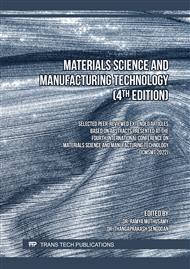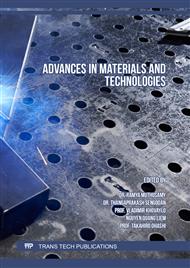[1]
V. Pandian and S. Kannan, Numerical prediction and experimental investigation of aerospace-grade dissimilar aluminium alloy by friction stir welding,, J. Manuf. Process., vol. 54, no. February, p.99–108, (2020).
DOI: 10.1016/j.jmapro.2020.03.001
Google Scholar
[2]
K. Sekar and P. Vasanthakumar, Microstructural evaluation of similar and dissimilar welding of aluminum metal matrix hybrid composite by friction stir welding,, Mater. Sci. Forum, vol. 979 MSF, p.124–128, (2020).
DOI: 10.4028/www.scientific.net/msf.979.124
Google Scholar
[3]
V. Saravanan, Nilotpal Banerjee, R. Amuthakkannan, S. Rajakumar, Microstructural Evolution and Mechanical Properties of Friction Stir Welded Dissimilar AA2014-T6 and AA7075-T6 Aluminium Alloy Joints, Metallogr. Microstruct. Anal. (2015) 4:178–187.
DOI: 10.1007/s13632-015-0199-z
Google Scholar
[4]
Sarpreet Singha, Gaurav Dhuriab; Investigation of post weld cryogenic treatment on weld strength in friction stir welded dissimilar aluminium alloys AA2014-T651 and AA7075-T651, Materials Today: Proceedings 4 (2017) 8866–8873.
DOI: 10.1016/j.matpr.2017.07.237
Google Scholar
[5]
Guven ipekoglu and Gurel Cam; Effects of Initial Temper Condition and Postweld Heat Treatment on the Properties of Dissimilar Friction-Stir-Welded Joints between AA7075 and AA6061 Aluminium Alloys, The Minerals, Metals & Materials Society and ASM International (2014).
DOI: 10.1007/s11661-014-2248-7
Google Scholar
[6]
S. Babu, G.D. Janaki Ram, P.V. Venkitakrishnan, G. Madhusudhan Reddy and K. Prasad Rao; Microstructure and Mechanical Properties of Friction Stir Lap Welded Aluminium Alloy AA2014, J. Mater. Sci. Technol., 2012, 28(5), 414–426.
DOI: 10.1016/s1005-0302(12)60077-2
Google Scholar
[7]
Aruri Devarajua, V Kishanb; Influence of Cryogenic cooling (Liquid Nitrogen) on Microstructure and Mechanical properties of Friction stir welded 2014-T6 Aluminium alloy, Materials Today: Proceedings 5 (2018) 1585–1590.
DOI: 10.1016/j.matpr.2017.11.250
Google Scholar
[8]
C. Rajendran, K. Srinivasan, V. Balasubramanian, H. Balaji & P. Selvaraj, Identifying the combination of friction stir welding parameters to attain maximum strength of AA2014-T6 aluminium alloy joints, (2017).
DOI: 10.1080/2374068x.2017.1410687
Google Scholar
[9]
P. Vijaya Kumar, G. Madhusudhan Reddy , K. Srinivasa Rao, Microstructure, mechanical and corrosion behavior of high strength AA7075 aluminium alloy friction stir welds e Effect of post weld heat treatment, Defence Technology 11 (2015).
DOI: 10.1016/j.dt.2015.04.003
Google Scholar
[10]
Sekar. K, Vasanthakumar. P Friction Stir Welding of Al-Cu Alloy Metal Matrix Composites Reinforced with B4C and Graphite Particle Fabricated by Stir Casting and Thixoforming Method, M. S. Shunmugam and M. Kanthababu, Advances in Additive Manufacturing and Joining,, in Editors Proceedings of AIMTDR, (2018).
DOI: 10.1007/978-981-32-9433-2_44
Google Scholar
[11]
P. Vasanthakumar, K. Sekar, and J. Jayantherababu, Thermal prediction and experimental validation of Friction Stir Welded Aerospace Grade Aluminium Alloy,, J. Phys. Conf. Ser., vol. 1240, no. 1, (2019).
DOI: 10.1088/1742-6596/1240/1/012150
Google Scholar
[12]
Shine, K., and K. Jayakumar. Effect of tool pin profile on the mechanical and microstructural properties of dissimilar friction stir welded AA5083-H111 and AA6061-T6 aluminium alloys., JOURNAL OF THE CHINESE INSTITUTE OF ENGINEERS 45, no. 3 (2022): 227-236.
DOI: 10.1080/02533839.2022.2034054
Google Scholar
[13]
P. Naveen Kumar, and K. Jayakumar. Influence of tool pin profiles in the strength enhancement of friction stir welded AA5083 and AA5754 alloys., Materials Research Express 9, no. 3 (2022): 036505.
DOI: 10.1088/2053-1591/ac5956
Google Scholar
[14]
Balamurugan, S., K. Jayakumar, and K. Subbaiah. Influence of friction stir welding parameters on dissimilar joints AA6061-T6 and AA5052-H32., Arabian Journal for Science and Engineering 46, no. 12 (2021): 11985-11998.
DOI: 10.1007/s13369-021-05773-7
Google Scholar



